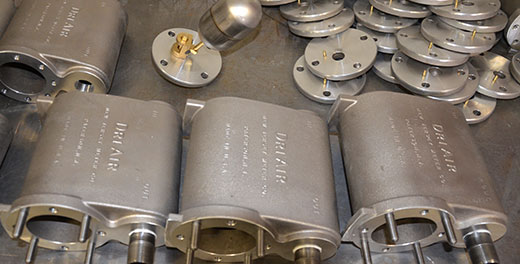Not known Factual Statements About Aluminum Castings Company
Table of ContentsAluminum Castings Company Fundamentals ExplainedGetting My Aluminum Castings Company To WorkThe Ultimate Guide To Aluminum Castings CompanyAbout Aluminum Castings CompanyGet This Report about Aluminum Castings CompanyNot known Facts About Aluminum Castings CompanyIndicators on Aluminum Castings Company You Need To KnowThe Basic Principles Of Aluminum Castings Company
There are 2 key kinds of die casting utilized in the aluminum spreading sector: hot chamber pass away spreading and cool chamber die casting. The main difference in between these methods is just how the molten metal is delivered to the mold and mildew. In hot chamber die casting, frequently used for reduced melting factor steels, the melting pot is directly linked to the equipment, and a plunger requires the product through a gooseneck right into the die tooth cavity.
Some Ideas on Aluminum Castings Company You Should Know
In these approaches, the mold is deliberately ruined or escaped in order to draw out the ended up light weight aluminum spreading. Typical processes under the group of expendable mold casting consist of (financial investment casting),,, and investment casting. When manufacturing personalized light weight aluminum components using expendable mold and mildews, suppliers pour molten light weight aluminum or light weight aluminum alloys right into the mold, which is after that damaged apart to release the solidified metal part.
The is one of the oldest and most utilized types of light weight aluminum spreading. It includes compacting specialized foundry sand, often enhanced with clay or resin, around a specifically crafted reusable pattern that establishes the shape and internal information of the ended up light weight aluminum item. The pattern system integrates risers and vents to manage the circulation of molten steel and to stop casting flaws such as contraction porosity.
What Does Aluminum Castings Company Do?

This mold is then preheated prior to the putting of molten light weight aluminum or light weight aluminum alloy. As the steel loads the shell, it catches the detailed information and great surface area coating of the mold and mildew. Once cooled down, the ceramic is mechanically or chemically damaged away, enabling the elimination and splitting up of private cast parts.
See This Report about Aluminum Castings Company
Irreversible mold and mildew spreading uses recyclable steel molds and is ideal for automation with consistent high quality and less waste. Expendable mold spreading utilizes single-use molds, like sand or foam, offering layout adaptability and reduced tooling expenses for prototypes or short runs. Die spreading is best for producing high quantities of light weight aluminum parts that require tight resistances, great details, and smooth surfaces.
The Toshiba Equipment DC-J Series includes pass away casting machines appropriate for light weight aluminum. Known for their robust building and high injection performance, these equipments ensure effective and exact spreading (Aluminum Foundry).

While light weight aluminum can be used in its pure kind, it is usually alloyed with various other steels to improve its buildings or the residential properties of the other steels. These alloys offer enhanced efficiency for various applications. Light weight aluminum alloys are categorized right into 8 series, phoned number from one to 8. The very first digit(s) of the number suggest the primary alloying component combined with aluminum.
Aluminum Castings Company Things To Know Before You Buy
This alloying enhances the stamina and hardness of light weight aluminum but decreases its ductility and deterioration resistance. The 3000 series alloys are primarily alloyed with manganese.
Additionally, it includes high ductility and an extremely smooth ended up surface area. The 4000 series alloys are alloyed with silicon, which lowers the melting point and boosts fluidity. This makes it a popular option for casting, as it is easy to create in its molten state. The 4000 series is additionally typically used as a filler for welding and brazing applications.
See This Report about Aluminum Castings Company
This series is classified as a high-strength alloy, particularly fit for sheet and plate applications as a result of its outstanding weldability. Its resistance to deterioration from acids and alkalis makes it you can try these out suitable for usage in rough and aggressive environments (Sand Molding). The 6000 series alloys are alloyed with both magnesium and silicon, offering a balance of toughness, mechanical buildings, and corrosion resistance
Processing the 6000 series requires specialized and sophisticated equipment, which can be complicated and costly. This series is recognized for its excellent deterioration and oxidation resistance, as well as its ease of coating, treatment, and workability. The 7000 collection light weight aluminum alloys are the best and most sturdy amongst light weight aluminum types, with strength equivalent to around two-thirds of industrial-grade A3 steel.
The Buzz on Aluminum Castings Company
Zinc is the main alloying aspect in the 7000 collection, improving the firmness of the light weight aluminum, despite the fact that zinc's hardness resembles that of aluminum on the Mohs range. The 8000 series light weight aluminum alloys are largely alloyed with tin, together with small amounts of copper and nickel (Sand Mold). While these alloys provide reduced stamina contrasted to various other series, they stand out in machinability and put on resistance
Aluminum cast heatsinks are electrically conductive, enabling them to be grounded efficiently. They are frequently cast with incorporated features that lessen the demand for additional operations, such as added machining or assembly, resulting in additional cost savings. Aluminum casting is frequently used to produce brackets for both durable industrial devices and household appliances.
The Main Principles Of Aluminum Castings Company
The single-piece building and construction of light weight aluminum brackets boosts their stamina and durability, reducing the probability of failing. If holes are called for, they can be included directly in the casting mold and mildew, reducing the need for post-production completing (https://www.cybo.com/US-biz/aluminum-castings-corporation_2k#google_vignette). Manufacturers have progressively embraced aluminum spreading for golf tools due to its toughness, security, and versatility in shaping